-
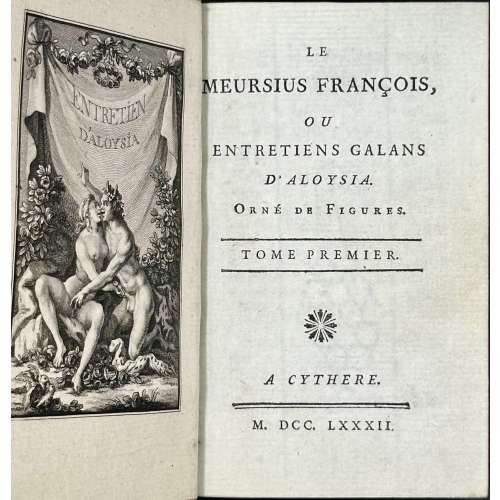 Hardcover volume, 12mo, 125 x 85 mm, two parts in one, bound and gilded by Cuzin and Maillard, respectively, between 1876 and 1881, in crimson crushed morocco with raised bands and gilt lettering to spine, marbled endpapers, all edges gilt, gilt dentelle, signed 'Cuzin' to foot of front turn-in and 'Maillard dor.' to rear. Adorned with engraved frontispiece and 12 plates by Elluin after Borel. Text printed on a slightly bluish paper. Title-page: LE | MEURSIUS FRANÇOIS, | OU | ENTRETIENS GALANS | D'ALOYSIA. | ORNÉ | DE FIGURES. | — | TOME PREMIER (SECOND) | — | ✵ | A CYTHERE | — | M. DCC. LXXXII. || Collation: 12mo, π4 (2 blanks) A-Z6 χ1,+ π2 A-S6 (4 blanks) χ1, total 254 leaves; pagination: [8] [1] 2-277 [278 blank], [4] [1] 2-210 [8 blanks], total 508 pages, plus 13 engraved plates, incl. frontispiece. Catalogue raisonné: Cohen-de Ricci 240; Eros invaincu 17; Fekete 51; Nordmann (I) 91. Contributors: Nicolas Chorier (French, 1612 – 1692) – author. Antoine Borel (French, 1743 – 1810) – artist. François-Rolland Elluin (French, 1745 – c. 1822) – engraver. Hubert-Martin Cazin (French, 1724 – 1795) – publisher. Francisque Cuzin (French, 1836 – 1890) – bookbinder. Seller’s description: Erotica.- [Chorier (Nicolas)]Le Meursius François, ou Entretiens galans d'Aloysia, 2 parts in 1, half-title to each part, engraved frontispiece and 12 plates [by Elluin after Borel], handsomely bound in crimson crushed morocco by Cuzin, spine with gilt lettering and five raised bands, gilt tooled turn-ins by Maillard, signed 'Cuzin' to foot of front turn-in and 'Maillard dor.' to rear, marbled endpapers, g.e., fractional rubbing to extremities, an excellent copy, 12mo, Cythere [but Paris], [Cazin], 1782.
Hardcover volume, 12mo, 125 x 85 mm, two parts in one, bound and gilded by Cuzin and Maillard, respectively, between 1876 and 1881, in crimson crushed morocco with raised bands and gilt lettering to spine, marbled endpapers, all edges gilt, gilt dentelle, signed 'Cuzin' to foot of front turn-in and 'Maillard dor.' to rear. Adorned with engraved frontispiece and 12 plates by Elluin after Borel. Text printed on a slightly bluish paper. Title-page: LE | MEURSIUS FRANÇOIS, | OU | ENTRETIENS GALANS | D'ALOYSIA. | ORNÉ | DE FIGURES. | — | TOME PREMIER (SECOND) | — | ✵ | A CYTHERE | — | M. DCC. LXXXII. || Collation: 12mo, π4 (2 blanks) A-Z6 χ1,+ π2 A-S6 (4 blanks) χ1, total 254 leaves; pagination: [8] [1] 2-277 [278 blank], [4] [1] 2-210 [8 blanks], total 508 pages, plus 13 engraved plates, incl. frontispiece. Catalogue raisonné: Cohen-de Ricci 240; Eros invaincu 17; Fekete 51; Nordmann (I) 91. Contributors: Nicolas Chorier (French, 1612 – 1692) – author. Antoine Borel (French, 1743 – 1810) – artist. François-Rolland Elluin (French, 1745 – c. 1822) – engraver. Hubert-Martin Cazin (French, 1724 – 1795) – publisher. Francisque Cuzin (French, 1836 – 1890) – bookbinder. Seller’s description: Erotica.- [Chorier (Nicolas)]Le Meursius François, ou Entretiens galans d'Aloysia, 2 parts in 1, half-title to each part, engraved frontispiece and 12 plates [by Elluin after Borel], handsomely bound in crimson crushed morocco by Cuzin, spine with gilt lettering and five raised bands, gilt tooled turn-ins by Maillard, signed 'Cuzin' to foot of front turn-in and 'Maillard dor.' to rear, marbled endpapers, g.e., fractional rubbing to extremities, an excellent copy, 12mo, Cythere [but Paris], [Cazin], 1782. -
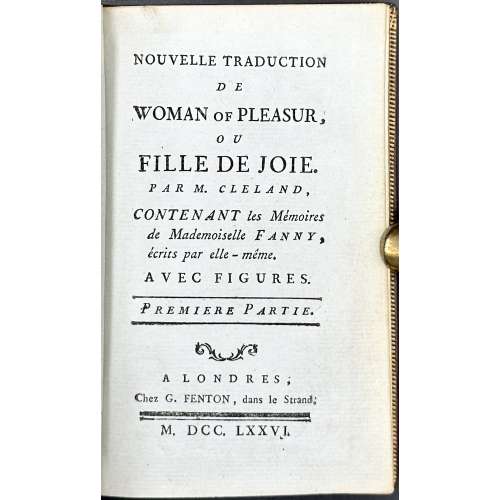 Hardcover volume, collated 18mo, 130 x 85 mm (2 parts in one). Contemporary burgundy morocco outlined with gilt triple fillet, flat spine gilt in compartments, brown morocco label gilt, all edges gilt, gilt dentelle, text printed on slightly blue laid paper with illegible watermark; dark blue endpapers, Tony Fekete (T. F.) bookplate by Wahorn to front pastedown. Frontispiece and 14 engraved plates by Elluin after Borel, with guard tissue. Graphite ms to h.t.: "Figures de Borrel. | Gravées pr. Elluin." Title-page: NOUVELLE TRADUCTION | DE | WOMAN OF PLEASUR, | OU | FILLE DE JOIE. | PAR M. CLELAND, | CONTENANT les Mémoires | de Mademoiselle FANNY, | écrits par elle – même. | AVEC FIGURES | — | PREMIERE (SECONDE) PARTIE. | — | ~ | A LONDRES; | Chez G. FENTON, dans le Strand; | — | M. DCC. LXXVI. || Collation: 18mo throughout A-O12/6, total 126 leaves plus 15 plates, incl. frontispiece. Pagination: separate for each part [1-5] 6-119 [120 blank], [1-3] 4-132, total 252 pages. Provenance: Tony Fekete (Christie’s 2014, № 54, p. 37; Price realized GBP 11,875): “[CLELAND, John (1709-1789).] Nouvelle traduction de Woman of Pleasur [sic] ou Fille de Joie. Contenant les Mémoires de Mademoiselle Fanny, écrits par elle-même. London [but Paris]: G. Fenton [Cazin], 1776. 2 volumes in one, duodecimo (128 x 80 mm). Printed on blue tinted paper. Frontispiece and 14 engraved plates on thick white paper by Elluin after Borel. (Short tear repaired in the margin of one plate, another plate with a faint dampstain touching the facing leaf of text.) Contemporary burgundy morocco, flat spine gilt in compartments, morocco label gilt, covers with a gilt triple fillet border, gilt edges, blue endpapers. THE MOST BEAUTIFUL 18TH-CENTURY ILLUSTRATED EDITION OF THIS CELEBRATED EROTIC NOVEL. An excellent copy bound in contemporary morocco. It is the second translation into French, but the first to include the exquisite plates by Elluin after Borel. These are some of the best illustrations by this remarkable partnership responsible for a number of important 18th-century libertine texts. Cohen-DeRicci 242-3; Dutel A-407 ; Gay-Lemonnyer II, 304; Pia Enfer, 915.” Catalogue raisonné: Dutel (I) A-407, p. 134; Cohen-DeRicci 242-3; Fekete (Christie's) 54, p. 37. Contributors: John Cleland (British, c. 1709 – 1789). François-Rolland Elluin (French, 1745 – c. 1822) Antoine Borel (French, 1743 – 1810) Hubert-Martin Cazin (French, 1724 – 1795) András Wahorn (Hungarian, b. 1953) Fekete, Tony Laszlo (Hungarian, b. 1972)
Hardcover volume, collated 18mo, 130 x 85 mm (2 parts in one). Contemporary burgundy morocco outlined with gilt triple fillet, flat spine gilt in compartments, brown morocco label gilt, all edges gilt, gilt dentelle, text printed on slightly blue laid paper with illegible watermark; dark blue endpapers, Tony Fekete (T. F.) bookplate by Wahorn to front pastedown. Frontispiece and 14 engraved plates by Elluin after Borel, with guard tissue. Graphite ms to h.t.: "Figures de Borrel. | Gravées pr. Elluin." Title-page: NOUVELLE TRADUCTION | DE | WOMAN OF PLEASUR, | OU | FILLE DE JOIE. | PAR M. CLELAND, | CONTENANT les Mémoires | de Mademoiselle FANNY, | écrits par elle – même. | AVEC FIGURES | — | PREMIERE (SECONDE) PARTIE. | — | ~ | A LONDRES; | Chez G. FENTON, dans le Strand; | — | M. DCC. LXXVI. || Collation: 18mo throughout A-O12/6, total 126 leaves plus 15 plates, incl. frontispiece. Pagination: separate for each part [1-5] 6-119 [120 blank], [1-3] 4-132, total 252 pages. Provenance: Tony Fekete (Christie’s 2014, № 54, p. 37; Price realized GBP 11,875): “[CLELAND, John (1709-1789).] Nouvelle traduction de Woman of Pleasur [sic] ou Fille de Joie. Contenant les Mémoires de Mademoiselle Fanny, écrits par elle-même. London [but Paris]: G. Fenton [Cazin], 1776. 2 volumes in one, duodecimo (128 x 80 mm). Printed on blue tinted paper. Frontispiece and 14 engraved plates on thick white paper by Elluin after Borel. (Short tear repaired in the margin of one plate, another plate with a faint dampstain touching the facing leaf of text.) Contemporary burgundy morocco, flat spine gilt in compartments, morocco label gilt, covers with a gilt triple fillet border, gilt edges, blue endpapers. THE MOST BEAUTIFUL 18TH-CENTURY ILLUSTRATED EDITION OF THIS CELEBRATED EROTIC NOVEL. An excellent copy bound in contemporary morocco. It is the second translation into French, but the first to include the exquisite plates by Elluin after Borel. These are some of the best illustrations by this remarkable partnership responsible for a number of important 18th-century libertine texts. Cohen-DeRicci 242-3; Dutel A-407 ; Gay-Lemonnyer II, 304; Pia Enfer, 915.” Catalogue raisonné: Dutel (I) A-407, p. 134; Cohen-DeRicci 242-3; Fekete (Christie's) 54, p. 37. Contributors: John Cleland (British, c. 1709 – 1789). François-Rolland Elluin (French, 1745 – c. 1822) Antoine Borel (French, 1743 – 1810) Hubert-Martin Cazin (French, 1724 – 1795) András Wahorn (Hungarian, b. 1953) Fekete, Tony Laszlo (Hungarian, b. 1972) -
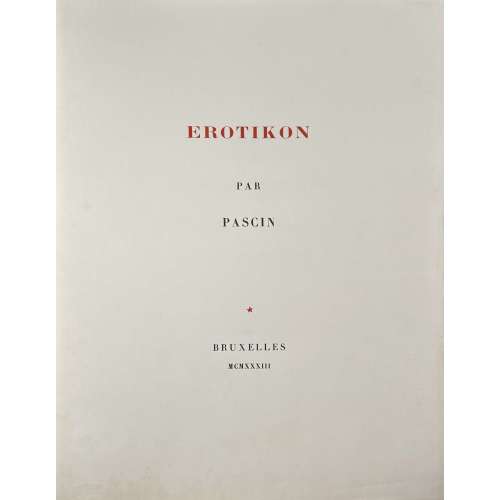 A portfolio of nine heliogravures after Jules Pascin. Cloth-backed cardboard portfolio 420 x 335 mm with 9 heliogravures on slightly tinted india paper, each numbered in pencil and mounted into a passe-partout 410 x 318 mm. Copy № 25 out of 40 printed on india (chine) paper. Copy № 25 of 40. Title (red and black): EROTIKON | PAR | PASCIN | ★ | BRUXELLES | MCMXXXIII || Limitation: CET | ALBUM | A ÉTÉ TIRÉ | A | QUARANTE ET UN EXEMPLAIRES | NUMÉROTÉS | DONT | UN EX. SUR PAPIER ANCIEN | & | QUARANTE EX. SUR CHINE | No (ms 25/40) || Catalogue raisonné: Dutel III № 1498. Seller's description:Neun Heliogravüren. 1933. Meist ca. 30 : 35 cm. Nummeriert. Exemplar 25/40 (Gesamtauflage 41). – Die Heliogravüren auf leicht getöntem China, jedes Blatt mit Bleistift nummeriert und in Passepartouts montiert. – Die neun Passepartouts eingelegt in zwei Büttenumschläge, einer mit Titel und dem nummerierten Auflagenvermerk, der zweite unbedruckt, ferner Büttenumschlag mit Titel in Rotdruck und Halbleinenchemise. – Die Heliogravüren erschienen 1933, drei Jahre nach Pascins Tod bei Daragnes in Paris mit der fingierten Angabe »Brüssel«. – Das berühmte Mappenwerk bildet eine der großen Seltenheiten der erotischen Kunst. Die Motive Pascins beschreibt das Bilderlexikon als »eine Art ›Boheme-Rokoko im Montmartre-Milieu‹« und lobt den Künstler: »Er ist ein außerordentlicher Zeichner, der es versteht, bei allem Zynismus, der seinen exhibitionistischen Charakter nicht verleugnet, auf diesem Kulturdünger eine neuartige Blume voll graziöser Schönheit erblühen zu lassen.« Mappe: 42 : 33,5 cm. – Der äußere Büttenumschlag mit leichtem Wasserrand. – Zwei Heliogravüren minimal stockfleckig, sonst tadellos und absolut vollständig. Dutel 1498 (mit Auflagenvarianten). – Der kalte Blick S. 198ff. – Bilderlexikon II, 718.
A portfolio of nine heliogravures after Jules Pascin. Cloth-backed cardboard portfolio 420 x 335 mm with 9 heliogravures on slightly tinted india paper, each numbered in pencil and mounted into a passe-partout 410 x 318 mm. Copy № 25 out of 40 printed on india (chine) paper. Copy № 25 of 40. Title (red and black): EROTIKON | PAR | PASCIN | ★ | BRUXELLES | MCMXXXIII || Limitation: CET | ALBUM | A ÉTÉ TIRÉ | A | QUARANTE ET UN EXEMPLAIRES | NUMÉROTÉS | DONT | UN EX. SUR PAPIER ANCIEN | & | QUARANTE EX. SUR CHINE | No (ms 25/40) || Catalogue raisonné: Dutel III № 1498. Seller's description:Neun Heliogravüren. 1933. Meist ca. 30 : 35 cm. Nummeriert. Exemplar 25/40 (Gesamtauflage 41). – Die Heliogravüren auf leicht getöntem China, jedes Blatt mit Bleistift nummeriert und in Passepartouts montiert. – Die neun Passepartouts eingelegt in zwei Büttenumschläge, einer mit Titel und dem nummerierten Auflagenvermerk, der zweite unbedruckt, ferner Büttenumschlag mit Titel in Rotdruck und Halbleinenchemise. – Die Heliogravüren erschienen 1933, drei Jahre nach Pascins Tod bei Daragnes in Paris mit der fingierten Angabe »Brüssel«. – Das berühmte Mappenwerk bildet eine der großen Seltenheiten der erotischen Kunst. Die Motive Pascins beschreibt das Bilderlexikon als »eine Art ›Boheme-Rokoko im Montmartre-Milieu‹« und lobt den Künstler: »Er ist ein außerordentlicher Zeichner, der es versteht, bei allem Zynismus, der seinen exhibitionistischen Charakter nicht verleugnet, auf diesem Kulturdünger eine neuartige Blume voll graziöser Schönheit erblühen zu lassen.« Mappe: 42 : 33,5 cm. – Der äußere Büttenumschlag mit leichtem Wasserrand. – Zwei Heliogravüren minimal stockfleckig, sonst tadellos und absolut vollständig. Dutel 1498 (mit Auflagenvarianten). – Der kalte Blick S. 198ff. – Bilderlexikon II, 718. -
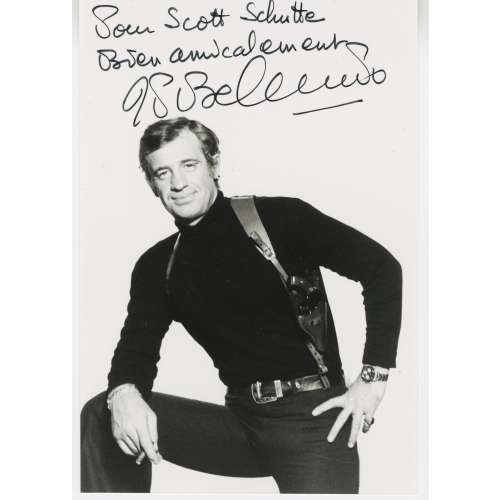 Three-quarter waist portrait of French actor Jean-Paul Belmondo in the film Peur sur la Ville, directed by Henri Verneuil in 1975. Autographed in black ink on a light area of the image above the head: “Pour Scott Schutte | Bien amicalement | J.P. Belmondo”. Paper watermarked "Agfa" in a diamond. Dimensions: 147 x 100 mm
Three-quarter waist portrait of French actor Jean-Paul Belmondo in the film Peur sur la Ville, directed by Henri Verneuil in 1975. Autographed in black ink on a light area of the image above the head: “Pour Scott Schutte | Bien amicalement | J.P. Belmondo”. Paper watermarked "Agfa" in a diamond. Dimensions: 147 x 100 mm -
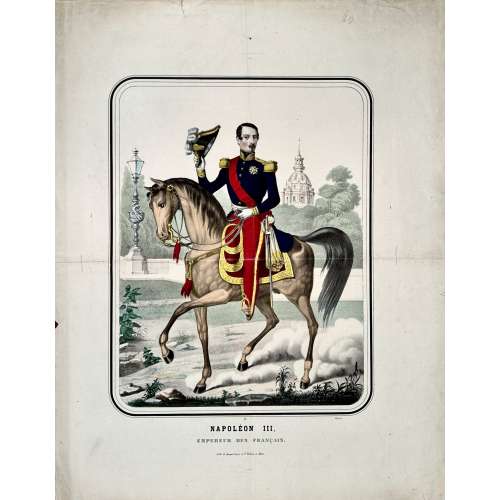 Hand-coloured chromolithography on wove paper, 600 x 470 mm; black ink stamp “4921” to reverse, horizontal and vertical centrefolds. Image of Napoléon III on horseback, in a frame; lettering under the frame: 34 — Déposé | NAPOLÉON III | EMPEREUR DES FRANÇAIS. | Lith. de Gangel frères et P. Didion, à Metz. || Gangel frères et P. Didion (Metz) – printer/publisher. Paulin Didion (French, 1831 – 1879)
Hand-coloured chromolithography on wove paper, 600 x 470 mm; black ink stamp “4921” to reverse, horizontal and vertical centrefolds. Image of Napoléon III on horseback, in a frame; lettering under the frame: 34 — Déposé | NAPOLÉON III | EMPEREUR DES FRANÇAIS. | Lith. de Gangel frères et P. Didion, à Metz. || Gangel frères et P. Didion (Metz) – printer/publisher. Paulin Didion (French, 1831 – 1879) -
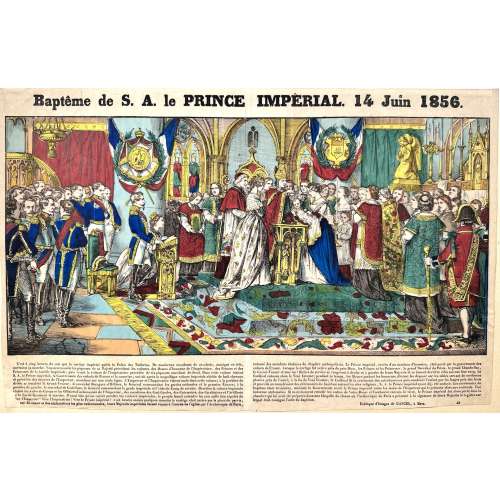 Hand-coloured woodcut on wove paper, 610 x 390 mm; black ink stamp “5207” to reverse, attached to a larger sheet of thick paper with a red ink stamp: “COLLECTION JEAN-CLAUD LACHNITT | REPRODUCTION INTERDIT”. Top: Baptême de S. A. le PRINCE IMPÉRIAL. 14 Juin 1856; image of baptism of Prince-Impérial; two-column text with a small loss in the lower left corner (C'est à cinq heures du soir que le cortège impérial quitta le Palais des Tuileries. De nombreux escadrons de cavalerie, musique en tête ouvraient la marche. ...); bottom under the text: "Fabrique d'Images de GANGEL, à Metz." — "49".
Hand-coloured woodcut on wove paper, 610 x 390 mm; black ink stamp “5207” to reverse, attached to a larger sheet of thick paper with a red ink stamp: “COLLECTION JEAN-CLAUD LACHNITT | REPRODUCTION INTERDIT”. Top: Baptême de S. A. le PRINCE IMPÉRIAL. 14 Juin 1856; image of baptism of Prince-Impérial; two-column text with a small loss in the lower left corner (C'est à cinq heures du soir que le cortège impérial quitta le Palais des Tuileries. De nombreux escadrons de cavalerie, musique en tête ouvraient la marche. ...); bottom under the text: "Fabrique d'Images de GANGEL, à Metz." — "49". -
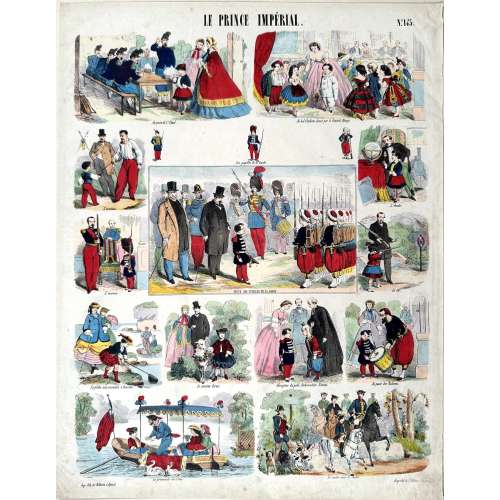 Hand-coloured woodcut on wove paper, 472 x 365 mm; black ink stamp “5275” to reverse. Top centre: "LE PRINCE IMPÉRIAL"; right: "№143." Image in the middle: Prince Impérial, with his father, conducts a review of the children's army "REVUE DES PUPILLES DE LA GARDE". Besides – five tiers of captioned cartoons. Bottom left: "Imp. lith. de Pellerin à Épinal"; right: Propriété de l’Éditeur. Déposé." Jean Charles Pellerin (French, 1756 – 1836) – printer/publisher.
Hand-coloured woodcut on wove paper, 472 x 365 mm; black ink stamp “5275” to reverse. Top centre: "LE PRINCE IMPÉRIAL"; right: "№143." Image in the middle: Prince Impérial, with his father, conducts a review of the children's army "REVUE DES PUPILLES DE LA GARDE". Besides – five tiers of captioned cartoons. Bottom left: "Imp. lith. de Pellerin à Épinal"; right: Propriété de l’Éditeur. Déposé." Jean Charles Pellerin (French, 1756 – 1836) – printer/publisher. -
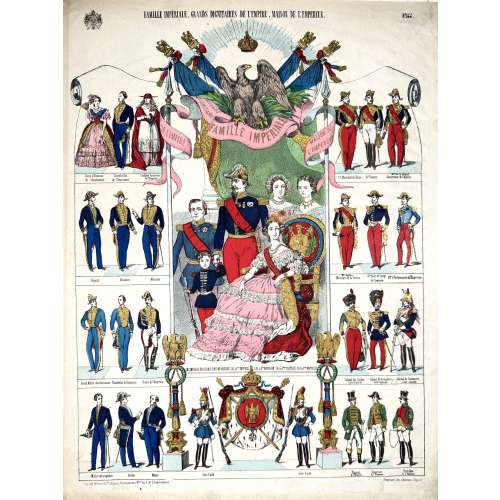 Hand-coloured woodcut on wove paper, 487 x 365 mm; black ink stamp “5056” to reverse. Top left: imperial coat of arms; centre: "FAMILLE IMPERIALE. GRANDS DIGNITAIRES DE L'EMPIRE, MAISON DE L'EMPEREUR."; right: "№144." Image of the imperial family under imperial eagle and standards; besides – four tiers of captioned cartoons. Bottom left: "Imprimerie Lith. de Pellerin, à Épinal"; right: "Propriété de l’Éditeur. — Déposé." Jean Charles Pellerin (French, 1756 – 1836) – printer/publisher.
Hand-coloured woodcut on wove paper, 487 x 365 mm; black ink stamp “5056” to reverse. Top left: imperial coat of arms; centre: "FAMILLE IMPERIALE. GRANDS DIGNITAIRES DE L'EMPIRE, MAISON DE L'EMPEREUR."; right: "№144." Image of the imperial family under imperial eagle and standards; besides – four tiers of captioned cartoons. Bottom left: "Imprimerie Lith. de Pellerin, à Épinal"; right: "Propriété de l’Éditeur. — Déposé." Jean Charles Pellerin (French, 1756 – 1836) – printer/publisher. -
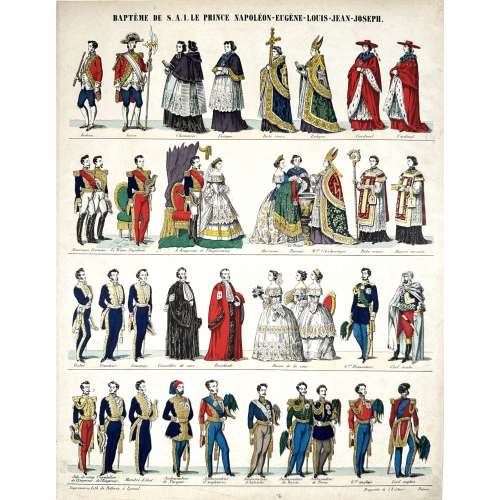 Hand-coloured woodcut on wove paper, 460 x 363 mm; black ink stamp “5054” to reverse. Four tiers with groups of people dressed in uniform, captioned: Bedeau — Suisse — Chanoines — Évêque — Porte croix — Évêque — Cardinal — Cardinal | Généraux français — Le prince Napoléon — L’Empereur et l’Impératrice — Marraine — Le Prince — Parrain | Meur l’Archevêque | Porte crosse Diacre servant | Préfet — Sénateur — Conseiller de cour — Président — Dames de la cour — Gral Piémontais — Chef arabe | Aide-de-camp de l’Empereur — Chambellan de l’Empereur — Ministre d’état — Ambassadeur de Turque | Ambassadeur d’Angleterre — Ambassadeur d’Autriche — Ambassadeur de Russie — Ambassadeur de Prusse — Gral anglaise — Lord anglais || Bottom left: Imprimerie Lith. de Pellerin, à Épinal; right: Propriété de l’Éditeur. — Déposé. Jean Charles Pellerin (French, 1756 – 1836) – printer/publisher.
Hand-coloured woodcut on wove paper, 460 x 363 mm; black ink stamp “5054” to reverse. Four tiers with groups of people dressed in uniform, captioned: Bedeau — Suisse — Chanoines — Évêque — Porte croix — Évêque — Cardinal — Cardinal | Généraux français — Le prince Napoléon — L’Empereur et l’Impératrice — Marraine — Le Prince — Parrain | Meur l’Archevêque | Porte crosse Diacre servant | Préfet — Sénateur — Conseiller de cour — Président — Dames de la cour — Gral Piémontais — Chef arabe | Aide-de-camp de l’Empereur — Chambellan de l’Empereur — Ministre d’état — Ambassadeur de Turque | Ambassadeur d’Angleterre — Ambassadeur d’Autriche — Ambassadeur de Russie — Ambassadeur de Prusse — Gral anglaise — Lord anglais || Bottom left: Imprimerie Lith. de Pellerin, à Épinal; right: Propriété de l’Éditeur. — Déposé. Jean Charles Pellerin (French, 1756 – 1836) – printer/publisher. -
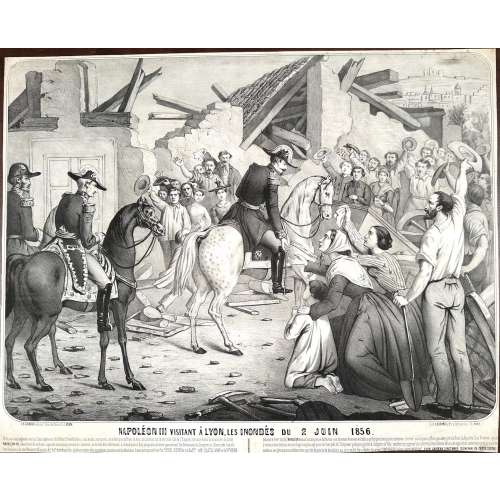 Lithography poster on wove paper, 492 x 614 mm; black ink stamp “5036” to reverse, vertical centerfold. Image in frame; under the frame left: "J. B. Gadola, éditeur. Cours de Brosses 1, à LYON."; right: "Lith LAURANT & Cie r. de Bernardins 34, Paris." Title and text below the image. Jean-Baptiste Gadola (French, 1818 – 1870) – publisher.
Lithography poster on wove paper, 492 x 614 mm; black ink stamp “5036” to reverse, vertical centerfold. Image in frame; under the frame left: "J. B. Gadola, éditeur. Cours de Brosses 1, à LYON."; right: "Lith LAURANT & Cie r. de Bernardins 34, Paris." Title and text below the image. Jean-Baptiste Gadola (French, 1818 – 1870) – publisher. -
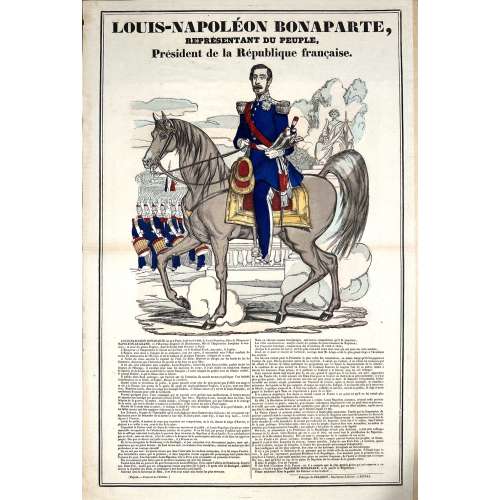 Hand-coloured woodcut poster on wove paper, 622 x 417 mm; black ink stamp “4859” to reverse, horizontal centrefold. In a double frame, top: LOUIS-NAPOLÉON BONAPARTE, | REPRÉSENTANT DU PEUPLE, | Président de la République française. Text under the image ; bottom left: (Déposé.— Propriété de l’Éditeur.); right: Fabrique de PELLERIN, Imprimeur-Libraire, à ÉPINAL. Jean Charles Pellerin (French, 1756 – 1836) – printer/publisher.
Hand-coloured woodcut poster on wove paper, 622 x 417 mm; black ink stamp “4859” to reverse, horizontal centrefold. In a double frame, top: LOUIS-NAPOLÉON BONAPARTE, | REPRÉSENTANT DU PEUPLE, | Président de la République française. Text under the image ; bottom left: (Déposé.— Propriété de l’Éditeur.); right: Fabrique de PELLERIN, Imprimeur-Libraire, à ÉPINAL. Jean Charles Pellerin (French, 1756 – 1836) – printer/publisher. -
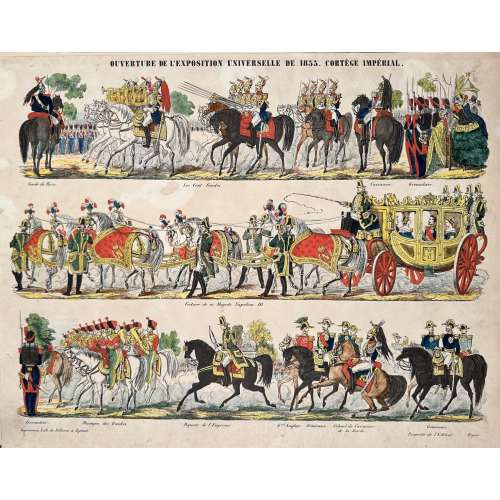 Hand-coloured woodcut on wove paper, 366 x 460 mm; black ink stamp “5057” to reverse. Caption cartoon in 2 tiers. Top: OUVERTURE DE 'EXPOSITION UNIVERSELLE DE 1855. CORTÈGE IMPÉRIAL. Captions top to bottom: Garde de Paris. — Les Cent Gardes. — Cuirassier. — Grenadiers. Middle: Voiture de sa Majesté Napoléon III. | Bottom: Grenadier. — Musique des Guides. — Piqueur de l’Empereur. — Gral Anglais — Généraux — Colonel de Cuirassiers | de la Garde — Généraux. Below left: Imprimerie Lith. de Pellerin, à Épinal; right: Propriété de l’Éditeur. Déposé. Jean Charles Pellerin (French, 1756 – 1836) – printer/publisher.
Hand-coloured woodcut on wove paper, 366 x 460 mm; black ink stamp “5057” to reverse. Caption cartoon in 2 tiers. Top: OUVERTURE DE 'EXPOSITION UNIVERSELLE DE 1855. CORTÈGE IMPÉRIAL. Captions top to bottom: Garde de Paris. — Les Cent Gardes. — Cuirassier. — Grenadiers. Middle: Voiture de sa Majesté Napoléon III. | Bottom: Grenadier. — Musique des Guides. — Piqueur de l’Empereur. — Gral Anglais — Généraux — Colonel de Cuirassiers | de la Garde — Généraux. Below left: Imprimerie Lith. de Pellerin, à Épinal; right: Propriété de l’Éditeur. Déposé. Jean Charles Pellerin (French, 1756 – 1836) – printer/publisher. -
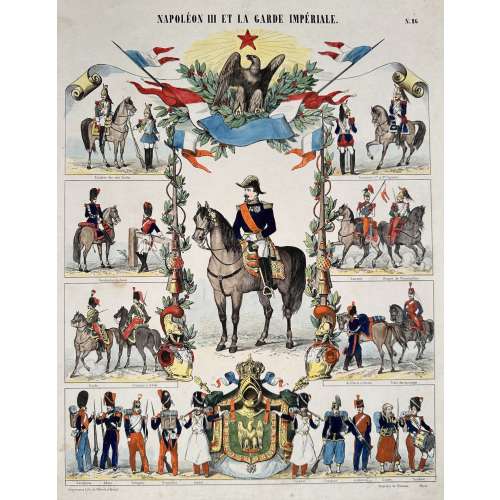 Hand-coloured woodcut on wove paper, 460 x 356 mm; black ink stamp “5055” to reverse. Top centre: "NAPOLÉON III ET LA GARDE IMPÉRIALE"; right: "№ 86". Napoléon III ahorseback in middle, beside (top to bottom): Escadron des cent Gardes — Cuirassiers 1er et 2me regiment; Gendarmes à cheval. — Lancier., Dragon de l’Impératrice.; Guide., Chasseur à cheval. — Artillerie à cheval, Train des équipages.; Gendarme. Génie. Voltigeur. Grenadier. Sapeur. Sapeur. Chasseur. Artillerie. Zouave. Tambour. Bottom left: Imprimerie Lith. de Pellerin à Épinal; right: Propriété de l’Éditeur. Déposé. Jean Charles Pellerin (French, 1756 – 1836) – printer/publisher.
Hand-coloured woodcut on wove paper, 460 x 356 mm; black ink stamp “5055” to reverse. Top centre: "NAPOLÉON III ET LA GARDE IMPÉRIALE"; right: "№ 86". Napoléon III ahorseback in middle, beside (top to bottom): Escadron des cent Gardes — Cuirassiers 1er et 2me regiment; Gendarmes à cheval. — Lancier., Dragon de l’Impératrice.; Guide., Chasseur à cheval. — Artillerie à cheval, Train des équipages.; Gendarme. Génie. Voltigeur. Grenadier. Sapeur. Sapeur. Chasseur. Artillerie. Zouave. Tambour. Bottom left: Imprimerie Lith. de Pellerin à Épinal; right: Propriété de l’Éditeur. Déposé. Jean Charles Pellerin (French, 1756 – 1836) – printer/publisher. -
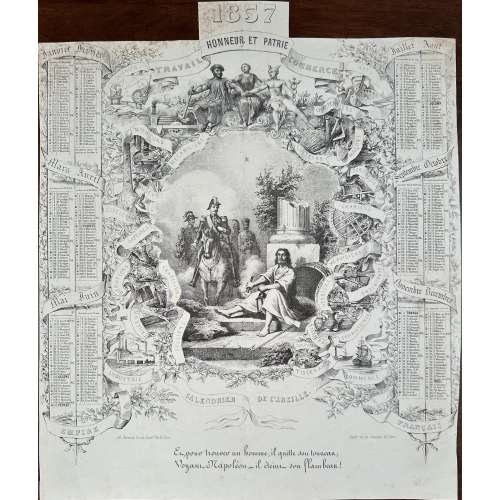 Lithography and etching on wove paper432 x 362 mm, black ink stamp “5022” to reverse, horizontal and vertical centrefolds. Depicts Diogenes (Ancient Greek, 412/404 – 323 BC) beside his barrel and extinguishing his torch when approached by Napoléon III ahorseback. Top: "1857 | HONNEUR ET PATRIE"; lettering on ribbons (top-down): SCIENCES, TRAVAIL, COMMERCE, ARTS, CHARPENTIERS, IMPRIMEURS, "MECHANICIENS, AGRICULTEURS, MAÇONS, FONDEURS, TERRASIERS, CIZELEURS, CARRIERS, ORFEVRES, BIJOUTIERS, CHAPELIERS, MENUISIERS, VERRIERS, SERRURIERS, TAILLEURS, SELLIERS, POTIERS, PORCELAINIERS, CORDONNIERS, TISSERANDS, INDUSTRIE, COMMERCE | CALENDRIER DE L'ABEILLE | EMPIRE, FRANÇAIS. Below left: "lith. Barousse Cour du Comm. 11 et 12. Paris"; right: "Dépôt rue des Cannettes, 20. Paris"; bottom: "Et, pour trouver un homme, il quitte son tonneau, | Voyant Napoléon, – il éteint son flambeau!" [And, to find a man, he leaves his barrel, | Seeing Napoleon, – he extinguishes his torch!]. Six months on the left and six months on the right-hand side of the calendar, surrounding the image.
Lithography and etching on wove paper432 x 362 mm, black ink stamp “5022” to reverse, horizontal and vertical centrefolds. Depicts Diogenes (Ancient Greek, 412/404 – 323 BC) beside his barrel and extinguishing his torch when approached by Napoléon III ahorseback. Top: "1857 | HONNEUR ET PATRIE"; lettering on ribbons (top-down): SCIENCES, TRAVAIL, COMMERCE, ARTS, CHARPENTIERS, IMPRIMEURS, "MECHANICIENS, AGRICULTEURS, MAÇONS, FONDEURS, TERRASIERS, CIZELEURS, CARRIERS, ORFEVRES, BIJOUTIERS, CHAPELIERS, MENUISIERS, VERRIERS, SERRURIERS, TAILLEURS, SELLIERS, POTIERS, PORCELAINIERS, CORDONNIERS, TISSERANDS, INDUSTRIE, COMMERCE | CALENDRIER DE L'ABEILLE | EMPIRE, FRANÇAIS. Below left: "lith. Barousse Cour du Comm. 11 et 12. Paris"; right: "Dépôt rue des Cannettes, 20. Paris"; bottom: "Et, pour trouver un homme, il quitte son tonneau, | Voyant Napoléon, – il éteint son flambeau!" [And, to find a man, he leaves his barrel, | Seeing Napoleon, – he extinguishes his torch!]. Six months on the left and six months on the right-hand side of the calendar, surrounding the image. -
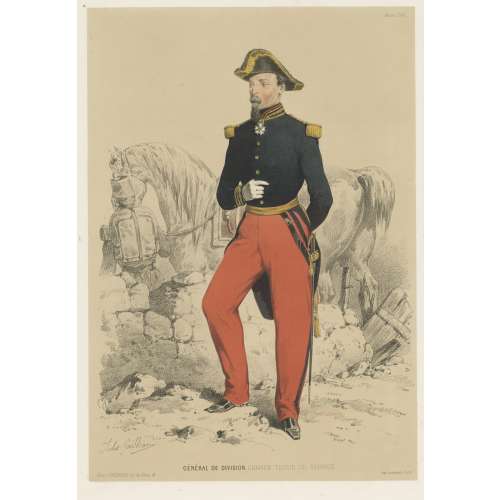 Chromolithography on thick wove paper, 473 x 315 mm sheet, 372 x 260 mm image, black ink stamp “5050” to reverse. Signed on stone "Jules Gaildrau"; below centre: "GÉNERAL DE DIVISION, GRANDE TENUE DE SERVICE"; Bottom left: "Paris, J. Gaildrau, rue de Seine, 16"; right: "Imp. Lemercier, Paris." Joseph Lemercier (French, 1803 – 1887) – printer. Jules Gaildrau (French, 1816 – 1898) – artist.
Chromolithography on thick wove paper, 473 x 315 mm sheet, 372 x 260 mm image, black ink stamp “5050” to reverse. Signed on stone "Jules Gaildrau"; below centre: "GÉNERAL DE DIVISION, GRANDE TENUE DE SERVICE"; Bottom left: "Paris, J. Gaildrau, rue de Seine, 16"; right: "Imp. Lemercier, Paris." Joseph Lemercier (French, 1803 – 1887) – printer. Jules Gaildrau (French, 1816 – 1898) – artist. -
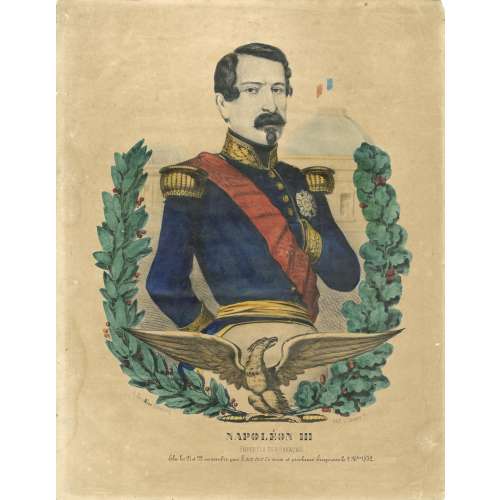 Hand-coloured lithography on wove paper, 380 x 298 mm; black ink stamp “4912” to reverse. On stone left: "A, Paris Miné Éditeur, imp.;" right: "Lith. R. St. Jacques. 41." Bottom center: "Napoléon III"; below: "EMPEREUR DES FRANÇAIS", under: "Élu les 21 el 22 novembre par 8,000,000 de voix et proclamé Empereur le 2 Xbre 1852." Printer/publisher: Miné, éditeur, imprimeur en lithographie, Rue Saint-Jacques, 41. Napoleon III [Charles-Louis Napoléon Bonaparte] (French, 1808 – 1873)
Hand-coloured lithography on wove paper, 380 x 298 mm; black ink stamp “4912” to reverse. On stone left: "A, Paris Miné Éditeur, imp.;" right: "Lith. R. St. Jacques. 41." Bottom center: "Napoléon III"; below: "EMPEREUR DES FRANÇAIS", under: "Élu les 21 el 22 novembre par 8,000,000 de voix et proclamé Empereur le 2 Xbre 1852." Printer/publisher: Miné, éditeur, imprimeur en lithographie, Rue Saint-Jacques, 41. Napoleon III [Charles-Louis Napoléon Bonaparte] (French, 1808 – 1873) -
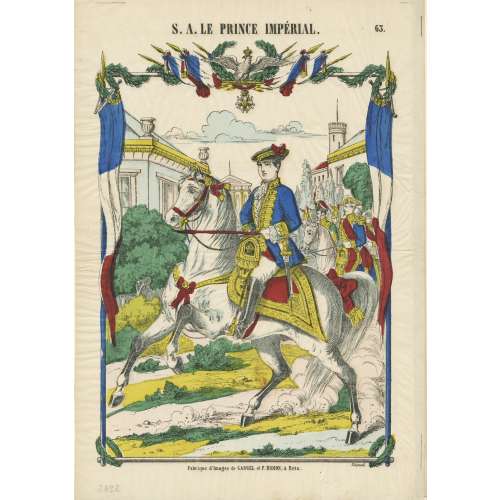 Hand-coloured woodcut on wove paper, 327 x 280 mm; black ink stamp “5265” to reverse, attached to the sheet 470 x 325 mm. Top centre: "S. A. LE PRINCE IMPÉRIAL.", right: "63." Image: equestiral portrait of Prince Impérial. Under the image, centre: "Fabrique d'Images de GANGEL et P. DIDION, à Metz." — "Déposé." Napoléon, Prince Imperial (Napoléon Eugène Louis Jean Joseph Bonaparte] (French, 1856 – 1879). Gangel et P. Didion (Metz); Paulin Didion (French, 1831 – 1879) – publisher/printer.
Hand-coloured woodcut on wove paper, 327 x 280 mm; black ink stamp “5265” to reverse, attached to the sheet 470 x 325 mm. Top centre: "S. A. LE PRINCE IMPÉRIAL.", right: "63." Image: equestiral portrait of Prince Impérial. Under the image, centre: "Fabrique d'Images de GANGEL et P. DIDION, à Metz." — "Déposé." Napoléon, Prince Imperial (Napoléon Eugène Louis Jean Joseph Bonaparte] (French, 1856 – 1879). Gangel et P. Didion (Metz); Paulin Didion (French, 1831 – 1879) – publisher/printer. -
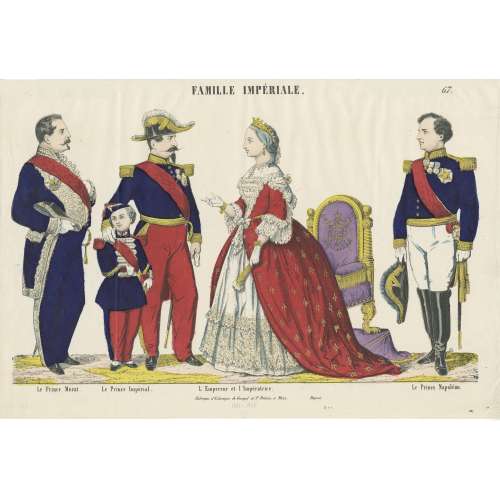 Hand-coloured woodcut on wove paper, 288 x 426 mm; black ink stamp “5305” to reverse. Top centre: "FAMILLE IMPÉRIALE", right: "67." Under the image: "Le Prince Murat." — "Le Prince Impérial." — "L' Empereur et l'Impératrice." — "Le Prince Napoléon." Bottom: "Fabrique d'Estampes de Gangel et P. Didion, à Metz." — "Déposé." Bottom: ms in pencil "1861 – 1868". Publisher/printer: Gangel et P. Didion (Metz); Paulin Didion (French, 1831 – 1879). Characters: Napoleon III [Charles-Louis Napoléon Bonaparte] (French, 1808 – 1873) Eugénie de Montijo [L'impératrice Eugénie] (Spanish-French, 1826 – 1920) Napoléon, Prince Imperial (Napoléon Eugène Louis Jean Joseph Bonaparte] (French, 1856 – 1879) Prince Murat [Lucien Charles Joseph Napoléon] (French, 1803 – 1878) Napoléon-Jérôme Bonaparte [Prince Napoléon] (French, 1822 – 1891)
Hand-coloured woodcut on wove paper, 288 x 426 mm; black ink stamp “5305” to reverse. Top centre: "FAMILLE IMPÉRIALE", right: "67." Under the image: "Le Prince Murat." — "Le Prince Impérial." — "L' Empereur et l'Impératrice." — "Le Prince Napoléon." Bottom: "Fabrique d'Estampes de Gangel et P. Didion, à Metz." — "Déposé." Bottom: ms in pencil "1861 – 1868". Publisher/printer: Gangel et P. Didion (Metz); Paulin Didion (French, 1831 – 1879). Characters: Napoleon III [Charles-Louis Napoléon Bonaparte] (French, 1808 – 1873) Eugénie de Montijo [L'impératrice Eugénie] (Spanish-French, 1826 – 1920) Napoléon, Prince Imperial (Napoléon Eugène Louis Jean Joseph Bonaparte] (French, 1856 – 1879) Prince Murat [Lucien Charles Joseph Napoléon] (French, 1803 – 1878) Napoléon-Jérôme Bonaparte [Prince Napoléon] (French, 1822 – 1891) -
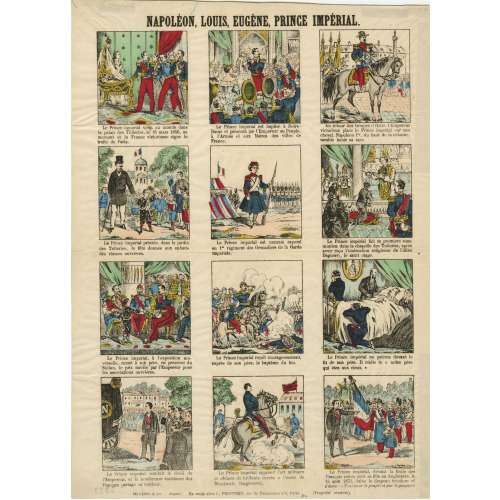 Another copy of SVFC-0745-3.2023, 395 x 290 mm; black ink stamp “5322” to reverse. Jean Charles Pellerin (French, 1756 – 1836)
Another copy of SVFC-0745-3.2023, 395 x 290 mm; black ink stamp “5322” to reverse. Jean Charles Pellerin (French, 1756 – 1836) -
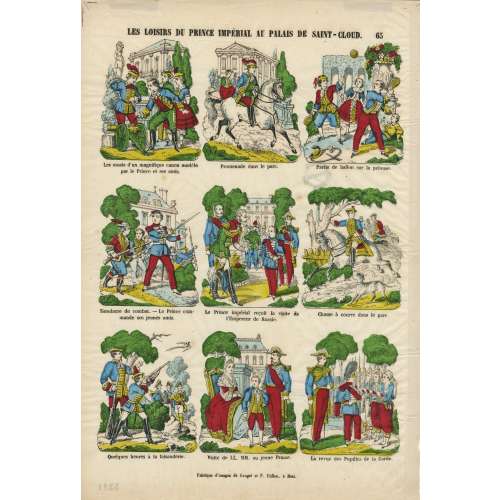 Hand-coloured woodcut on wove paper, 400 x 280 mm; black ink stamp “5321” to reverse. Top: "LES LOISIRS DU PRINCE IMPERIAL AU PALAIS DE SAINT- CLOUD" — "65". Below: nine cartoons with captions.
Hand-coloured woodcut on wove paper, 400 x 280 mm; black ink stamp “5321” to reverse. Top: "LES LOISIRS DU PRINCE IMPERIAL AU PALAIS DE SAINT- CLOUD" — "65". Below: nine cartoons with captions.- Les essais d'un magnifique canon modèle par le Prince et ses amis.
- Promenade dans le parc.
- Partie de ballon sur la pelouse.
- Simulacre de combat. — Le Prince commande ses jeunes amis.
- le Prince impérial reçoit la visite de l'Empereur de Russie.
- Chasse à courre dans le parc.
- Quelques heures à la faisanderie.
- Visite de LL. MM. au jeune Prince.
- La revue des Pupilles de la Garde.
-
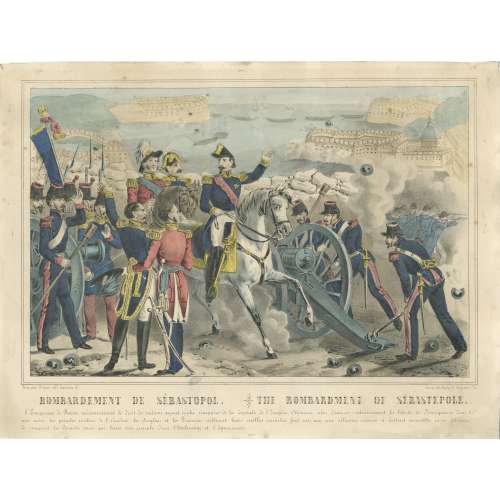 Hand-coloured lithography on wove paper, 250 x 332 mm; black ink stamp “5035” to reverse. Under the frame left: "Paris, chez Riboni, éd. r. Galande, 51"; right: "Paris, lith. Bulla, Pl. Maubert, 26". Below: "BOMBARDEMENT DE SEBASTOPOL. — THE BOMBARDMENT OF SÉBASTOPOLE". Text to bottom. Printers/publishers: Antoine Bulla (fl. 1815 – 1877), François Bulla (fl. c. 1814 – 1855).
Hand-coloured lithography on wove paper, 250 x 332 mm; black ink stamp “5035” to reverse. Under the frame left: "Paris, chez Riboni, éd. r. Galande, 51"; right: "Paris, lith. Bulla, Pl. Maubert, 26". Below: "BOMBARDEMENT DE SEBASTOPOL. — THE BOMBARDMENT OF SÉBASTOPOLE". Text to bottom. Printers/publishers: Antoine Bulla (fl. 1815 – 1877), François Bulla (fl. c. 1814 – 1855). -
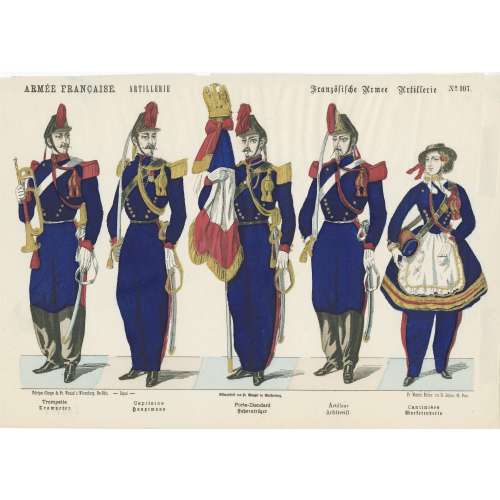 Hand-coloured woodcut on wove paper, 265 x 378 mm; black ink stamp “5051 1” to reverse. Top left: "ARMÉE FRANCAISE. ARTILLERIE"; right: (gothic font) "Französische Armee Artillerie" — "№ 107". Below left: "Fabrique d’Images de Fr. Wentzel à Wissembeurg. Bas-Rhin." — "Déposé" —, centre: "Bilderfabrit von Fr. Wentzel in Weissenburg", right: "Fr. Wentzel, Éditeur, rue St. Jacques, 65, Paris". Bottom: "Trompette | Trompeter" — "Capitaine | Gauptmann" — "Porte-Étendard | Fahnenträger" — "Artilleur | Artillerist" — "Cantinière | Marketenderin". Jean Frédéric Wentzel (French, 1807 – 1869) – publisher/printer.
Hand-coloured woodcut on wove paper, 265 x 378 mm; black ink stamp “5051 1” to reverse. Top left: "ARMÉE FRANCAISE. ARTILLERIE"; right: (gothic font) "Französische Armee Artillerie" — "№ 107". Below left: "Fabrique d’Images de Fr. Wentzel à Wissembeurg. Bas-Rhin." — "Déposé" —, centre: "Bilderfabrit von Fr. Wentzel in Weissenburg", right: "Fr. Wentzel, Éditeur, rue St. Jacques, 65, Paris". Bottom: "Trompette | Trompeter" — "Capitaine | Gauptmann" — "Porte-Étendard | Fahnenträger" — "Artilleur | Artillerist" — "Cantinière | Marketenderin". Jean Frédéric Wentzel (French, 1807 – 1869) – publisher/printer. -
 Hand-coloured woodcut on wove paper, 400 x 270 mm; black ink stamp “5306” to reverse. Top centre: "FAMILLE IMPÉRIALE", right: "62."; below centre: "Fabrique d'Images de GANGEL et P. DIDION, à Metz."; right: "Déposé." Publisher/printer: Gangel et P. Didion (Metz); Paulin Didion (French, 1831 – 1879). Characters: Napoleon III [Charles-Louis Napoléon Bonaparte] (French, 1808 – 1873) Eugénie de Montijo [L'impératrice Eugénie] (Spanish-French, 1826 – 1920) Napoléon, Prince Imperial (Napoléon Eugène Louis Jean Joseph Bonaparte] (French, 1856 – 1879) Napoléon II [Napoléon François Joseph Charles Bonaparte] (French, 1811 – 1832) Napoléon Ier [Napoléon Bonaparte] (French, 1769 – 1821)
Hand-coloured woodcut on wove paper, 400 x 270 mm; black ink stamp “5306” to reverse. Top centre: "FAMILLE IMPÉRIALE", right: "62."; below centre: "Fabrique d'Images de GANGEL et P. DIDION, à Metz."; right: "Déposé." Publisher/printer: Gangel et P. Didion (Metz); Paulin Didion (French, 1831 – 1879). Characters: Napoleon III [Charles-Louis Napoléon Bonaparte] (French, 1808 – 1873) Eugénie de Montijo [L'impératrice Eugénie] (Spanish-French, 1826 – 1920) Napoléon, Prince Imperial (Napoléon Eugène Louis Jean Joseph Bonaparte] (French, 1856 – 1879) Napoléon II [Napoléon François Joseph Charles Bonaparte] (French, 1811 – 1832) Napoléon Ier [Napoléon Bonaparte] (French, 1769 – 1821) -
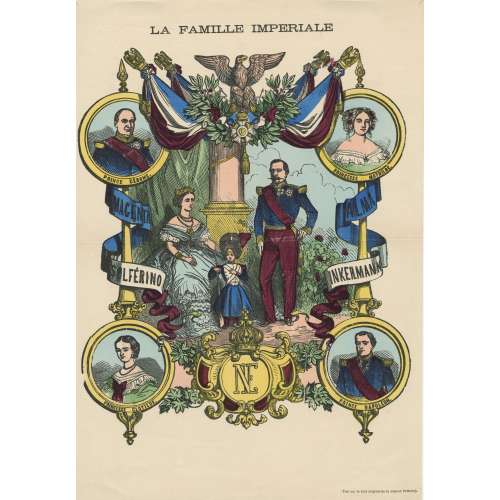 Hand-coloured woodcut on laid paper, 422 x 294 mm; black ink stamp “5307” to reverse, centrefold. Top center: "LA FAMILLE IMPERIALE"; Bottom right: "(Tire sur le bois original de maison Pellerin)". Image: Napoléon III, Empress Eugenie, and Prince Imperial Louis-Napoléon as a child surrounded with four lettered medallions: “PRINCE GÉROME”, “PRINCESSE MATHILDE”, “PRINCESSE CLOTILDE”, and “PRINCE NAPOLÉON”; ribbons lettered: “MAGENTA”, SOLFERINO”, “ALMA”, and “INKERMANN” around heraldic spears; coat of arms with imperial monogram between Princesse Clotilde and Prince Napoléon. Publisher/printer: Jean Charles Pellerin (French, 1756 – 1836). Battle of Magenta : 4 June 1859, against the Austrians. Battle of Solferino : 24 June 1859, against the Austrians. Battle of the Alma : 20 September 1854 (Crimean War) Battle of Inkerman : 5 November 1854 (Crimean War) Characters: Napoleon III [Charles-Louis Napoléon Bonaparte] (French, 1808 – 1873) Eugénie de Montijo [L'impératrice Eugénie] (Spanish-French, 1826 – 1920) Napoléon, Prince Imperial (Napoléon Eugène Louis Jean Joseph Bonaparte] (French, 1856 – 1879) Napoléon-Jérôme Bonaparte [Prince Jérôme] (French, 1822 – 1891) Mathilde Bonaparte [Princess Mathilde] (French, 1820 – 1904) Marie-Clotilde de Savoie [Princesse Clotilde] (French, 1843 – 1911)
Hand-coloured woodcut on laid paper, 422 x 294 mm; black ink stamp “5307” to reverse, centrefold. Top center: "LA FAMILLE IMPERIALE"; Bottom right: "(Tire sur le bois original de maison Pellerin)". Image: Napoléon III, Empress Eugenie, and Prince Imperial Louis-Napoléon as a child surrounded with four lettered medallions: “PRINCE GÉROME”, “PRINCESSE MATHILDE”, “PRINCESSE CLOTILDE”, and “PRINCE NAPOLÉON”; ribbons lettered: “MAGENTA”, SOLFERINO”, “ALMA”, and “INKERMANN” around heraldic spears; coat of arms with imperial monogram between Princesse Clotilde and Prince Napoléon. Publisher/printer: Jean Charles Pellerin (French, 1756 – 1836). Battle of Magenta : 4 June 1859, against the Austrians. Battle of Solferino : 24 June 1859, against the Austrians. Battle of the Alma : 20 September 1854 (Crimean War) Battle of Inkerman : 5 November 1854 (Crimean War) Characters: Napoleon III [Charles-Louis Napoléon Bonaparte] (French, 1808 – 1873) Eugénie de Montijo [L'impératrice Eugénie] (Spanish-French, 1826 – 1920) Napoléon, Prince Imperial (Napoléon Eugène Louis Jean Joseph Bonaparte] (French, 1856 – 1879) Napoléon-Jérôme Bonaparte [Prince Jérôme] (French, 1822 – 1891) Mathilde Bonaparte [Princess Mathilde] (French, 1820 – 1904) Marie-Clotilde de Savoie [Princesse Clotilde] (French, 1843 – 1911) -
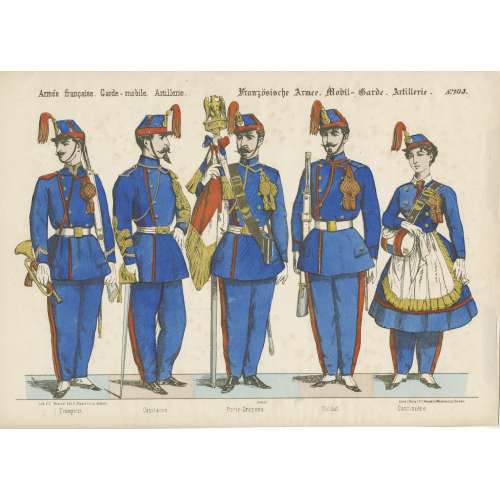 Hand-coloured woodcut on wove paper, 282 x 392 mm; black ink stamp “5051 2” to reverse. Top: "Armée française. Garde–mobile. Artillerie." — (gothic font) "Französische Armee. Mobil–Garde. Artillerie." — "№103". Below left: "Lith F. C. Wentzel édit. à Wissembourg. (Alsacé); center: Déposé; right: Druck u. Verlag v. F. C. Wentzel in Weissemburg. (Elsass)."; Bottom: "Trompette" — "Capitaine" — "Porte-Drapeau". — "Soldat" — "Cantinière." Jean Frédéric Wentzel (French, 1807 – 1869) – publisher/printer.
Hand-coloured woodcut on wove paper, 282 x 392 mm; black ink stamp “5051 2” to reverse. Top: "Armée française. Garde–mobile. Artillerie." — (gothic font) "Französische Armee. Mobil–Garde. Artillerie." — "№103". Below left: "Lith F. C. Wentzel édit. à Wissembourg. (Alsacé); center: Déposé; right: Druck u. Verlag v. F. C. Wentzel in Weissemburg. (Elsass)."; Bottom: "Trompette" — "Capitaine" — "Porte-Drapeau". — "Soldat" — "Cantinière." Jean Frédéric Wentzel (French, 1807 – 1869) – publisher/printer. -
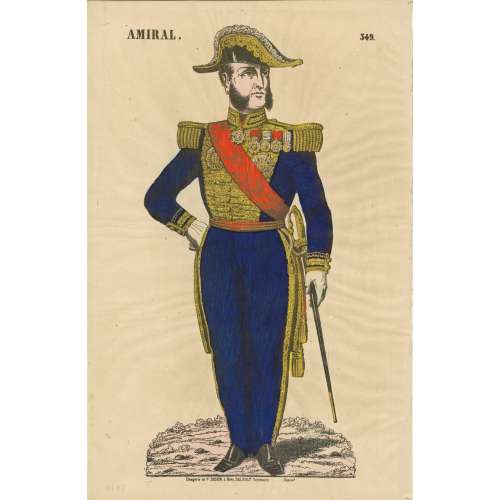 Hand-coloured woodcut on wove paper, 440 x 285 mm; black ink stamp “5049” to reverse. Top left: "AMIRAL"; right: "349". Below: "Imagerie de DIDION, à Metz, DELHALT Successeur." — "Déposé." Paulin Didion (French, 1831 – 1879) – publisher/printer.
Hand-coloured woodcut on wove paper, 440 x 285 mm; black ink stamp “5049” to reverse. Top left: "AMIRAL"; right: "349". Below: "Imagerie de DIDION, à Metz, DELHALT Successeur." — "Déposé." Paulin Didion (French, 1831 – 1879) – publisher/printer. -
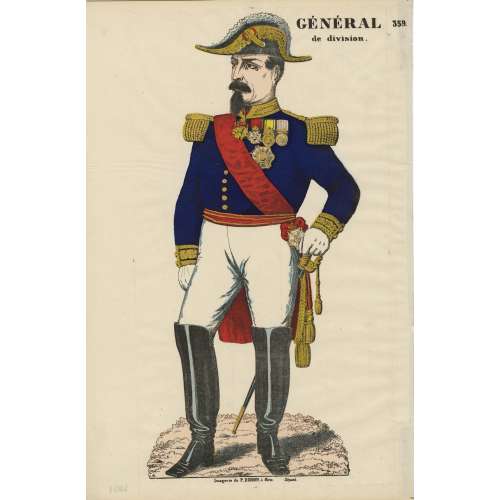 Hand-coloured woodcut on wove paper, 430 x 285 mm; black ink stamp “5051” to reverse. Top right: "GÉNÉRAL | de division." — "359." Bottom: "Imagerie de DIDION, à Metz. Déposé." Paulin Didion (French, 1831 – 1879) – publisher/printer.
Hand-coloured woodcut on wove paper, 430 x 285 mm; black ink stamp “5051” to reverse. Top right: "GÉNÉRAL | de division." — "359." Bottom: "Imagerie de DIDION, à Metz. Déposé." Paulin Didion (French, 1831 – 1879) – publisher/printer. -
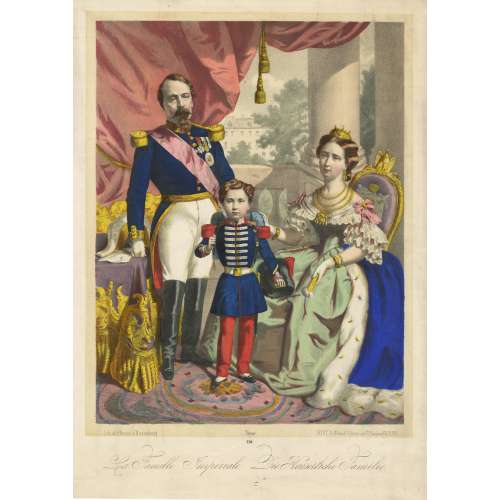 Hand-coloured lithography on wove paper, 395 x 280 mm; black ink stamp “5309” to reverse. On image: artist's initials "L. H."; on stone: "Lith. de Fr. Wentzel a Wissembourg. — Déposé — DÉPÔT, Fr. Wentzel Editeur rue St. Jacques 65, PARIS"; below centre: "239"; bottom : La famille Impériale. Die Kaizerliche Familie. Napoleon III [Charles-Louis Napoléon Bonaparte] (French, 1808 – 1873) Eugénie de Montijo [L'impératrice Eugénie] (Spanish-French, 1826 – 1920) Napoléon, Prince Imperial (Napoléon Eugène Louis Jean Joseph Bonaparte] (French, 1856 – 1879) Jean Frédéric Wentzel (French, 1807 – 1869) – publisher/printer.
Hand-coloured lithography on wove paper, 395 x 280 mm; black ink stamp “5309” to reverse. On image: artist's initials "L. H."; on stone: "Lith. de Fr. Wentzel a Wissembourg. — Déposé — DÉPÔT, Fr. Wentzel Editeur rue St. Jacques 65, PARIS"; below centre: "239"; bottom : La famille Impériale. Die Kaizerliche Familie. Napoleon III [Charles-Louis Napoléon Bonaparte] (French, 1808 – 1873) Eugénie de Montijo [L'impératrice Eugénie] (Spanish-French, 1826 – 1920) Napoléon, Prince Imperial (Napoléon Eugène Louis Jean Joseph Bonaparte] (French, 1856 – 1879) Jean Frédéric Wentzel (French, 1807 – 1869) – publisher/printer. -
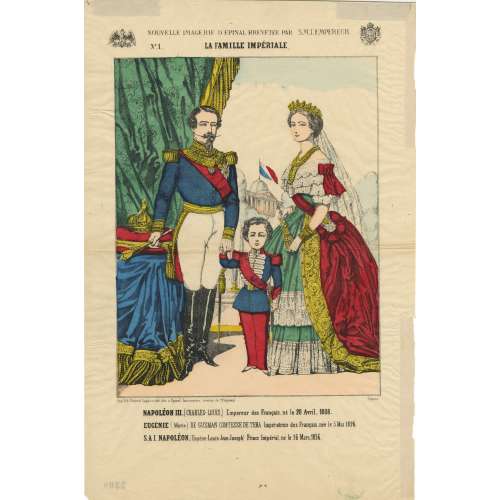 Hand-coloured woodcut on wove paper, 390 x 260 mm; black ink stamp “5308” to reverse; horizontal centerfold. Centre top: "NOUVELLE IMAGERIE D'ÉPINAL BREVETÉE PAR S.M.L’EMPEREUR" with imperial eagle and coat of arms at right and left. Below: "№ 1." — "LA FAMILLE IMPÉRIALE"; image in frame; under the image, left: "Imp lith. Pinot & Sagaire, édit. libr. à Épinal, fournisseurs brevetés de l’Empereur"; right: "Déposé". Bottom: "NAPOLÉON I. (CHARLES-LOUIS,) Empereur des Français, né le 20 Avril, 1808. | EUGÉNIE ( Marie) DE GUSMAN COMTESSE DE TEBA Impératrice des Français, née le 5 Mai 1826. | S.A I. NAPOLÉON. (Eugène-Louis-Jean-Joseph) Prince Impérial, ne le 16 Mars. 1856." Napoleon III [Charles-Louis Napoléon Bonaparte] (French, 1808 – 1873) Eugénie de Montijo [L'impératrice Eugénie] (Spanish-French, 1826 – 1920) Napoléon, Prince Imperial (Napoléon Eugène Louis Jean Joseph Bonaparte] (French, 1856 – 1879) Pinot & Sagaire (Épinal, 1861 – 1888) – enterprise, publisher/printer. Charles-François Pinot (French, 1817 – 1879) – publisher/printer.
Hand-coloured woodcut on wove paper, 390 x 260 mm; black ink stamp “5308” to reverse; horizontal centerfold. Centre top: "NOUVELLE IMAGERIE D'ÉPINAL BREVETÉE PAR S.M.L’EMPEREUR" with imperial eagle and coat of arms at right and left. Below: "№ 1." — "LA FAMILLE IMPÉRIALE"; image in frame; under the image, left: "Imp lith. Pinot & Sagaire, édit. libr. à Épinal, fournisseurs brevetés de l’Empereur"; right: "Déposé". Bottom: "NAPOLÉON I. (CHARLES-LOUIS,) Empereur des Français, né le 20 Avril, 1808. | EUGÉNIE ( Marie) DE GUSMAN COMTESSE DE TEBA Impératrice des Français, née le 5 Mai 1826. | S.A I. NAPOLÉON. (Eugène-Louis-Jean-Joseph) Prince Impérial, ne le 16 Mars. 1856." Napoleon III [Charles-Louis Napoléon Bonaparte] (French, 1808 – 1873) Eugénie de Montijo [L'impératrice Eugénie] (Spanish-French, 1826 – 1920) Napoléon, Prince Imperial (Napoléon Eugène Louis Jean Joseph Bonaparte] (French, 1856 – 1879) Pinot & Sagaire (Épinal, 1861 – 1888) – enterprise, publisher/printer. Charles-François Pinot (French, 1817 – 1879) – publisher/printer. -
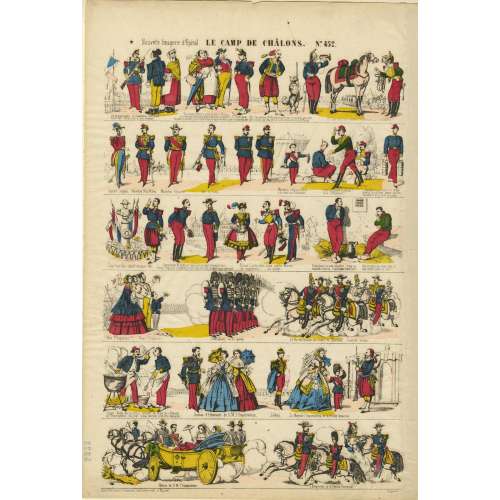 Hand-coloured woodcut on wove paper, 409 x 280 mm; black ink stamp “5323” to reverse; attached to the sheet 487 x 320 mm. Top centre: "LE CAMP DE CHALONS."; left: "Nouvelle Imagerre d'Epinal"; right: № 452. Bottom left: "Imp lith. Pinot & Sagaire, libraires edit. à Épinal"; right: "Déposé". Image: 6-tier cartoon with captions about Napoleon III and his son Prince Imperial (Napoléon Eugène Louis Jean Joseph Bonaparte; 16 March 1856 – 1 June 1879). Le camp de Chalons Pinot & Sagaire (Épinal, 1861 – 1888) – enterprise, publisher/printer. Charles-François Pinot (French, 1817 – 1879) – publisher/printer.
Hand-coloured woodcut on wove paper, 409 x 280 mm; black ink stamp “5323” to reverse; attached to the sheet 487 x 320 mm. Top centre: "LE CAMP DE CHALONS."; left: "Nouvelle Imagerre d'Epinal"; right: № 452. Bottom left: "Imp lith. Pinot & Sagaire, libraires edit. à Épinal"; right: "Déposé". Image: 6-tier cartoon with captions about Napoleon III and his son Prince Imperial (Napoléon Eugène Louis Jean Joseph Bonaparte; 16 March 1856 – 1 June 1879). Le camp de Chalons Pinot & Sagaire (Épinal, 1861 – 1888) – enterprise, publisher/printer. Charles-François Pinot (French, 1817 – 1879) – publisher/printer. -
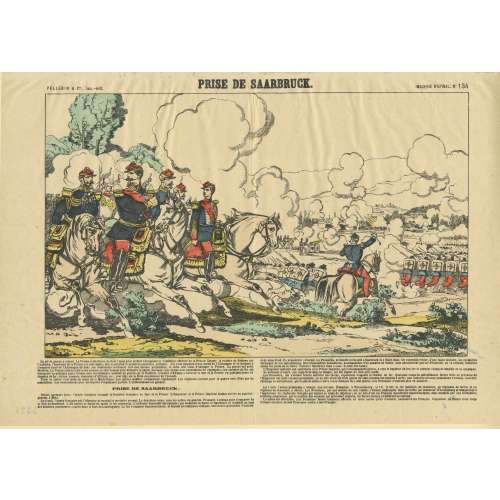 Hand-coloured woodcut on wove paper, 268 x 381 mm, vertical centerfold. On reverse: black ink stamp “5324”. Top centre: "PRISE DE SAARBRUCK"; left: "PELLERIN & Cie, imp. -édit."; right: "IMAGERIE D'EPINAL, № 134." Under the frame text starts with « La cri de guerre a retenti. La France a été forcée de tirer l’épée pour arrêter… ».[...] Prise de Saarbruck. | Depuis quelques jours, l’armée française occupait la frontière française en face de la Prusse.... Jean Charles Pellerin (French, 1756 – 1836) – publisher/printer. The Battle of Saarbrücken (2 August 1870).
Hand-coloured woodcut on wove paper, 268 x 381 mm, vertical centerfold. On reverse: black ink stamp “5324”. Top centre: "PRISE DE SAARBRUCK"; left: "PELLERIN & Cie, imp. -édit."; right: "IMAGERIE D'EPINAL, № 134." Under the frame text starts with « La cri de guerre a retenti. La France a été forcée de tirer l’épée pour arrêter… ».[...] Prise de Saarbruck. | Depuis quelques jours, l’armée française occupait la frontière française en face de la Prusse.... Jean Charles Pellerin (French, 1756 – 1836) – publisher/printer. The Battle of Saarbrücken (2 August 1870). -
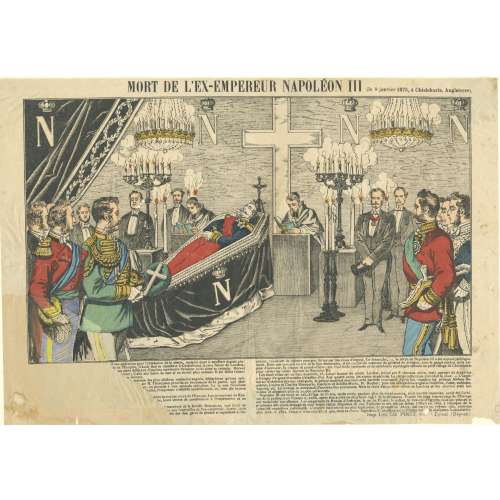 Hand-coloured woodcut on wove paper, 270 x 380 mm; attached to the sheet 303 x 442 mm with pencil ms inscription to the top left corner on the reverse: “Haye le 2-3-75”. Top: "MORT DE L'EX-EMPEREUR NAPOLÉON III (le 9 janvier 1873, à Chislehurts [sic], Angleterre)." Bottom right: "Imp. Lith. CH. PINOT, éditeur. Épinal (Dépose)". Bottom left corner of the image sheet torn and manually restored. Text partially lost, starting with « d’une opération pour l’extraction de la pierre, maladie dont’ il souffrait depuis plu-… ». See Chislehurst. Charles-François Pinot (French, 1817 – 1879) – publisher/printer.
Hand-coloured woodcut on wove paper, 270 x 380 mm; attached to the sheet 303 x 442 mm with pencil ms inscription to the top left corner on the reverse: “Haye le 2-3-75”. Top: "MORT DE L'EX-EMPEREUR NAPOLÉON III (le 9 janvier 1873, à Chislehurts [sic], Angleterre)." Bottom right: "Imp. Lith. CH. PINOT, éditeur. Épinal (Dépose)". Bottom left corner of the image sheet torn and manually restored. Text partially lost, starting with « d’une opération pour l’extraction de la pierre, maladie dont’ il souffrait depuis plu-… ». See Chislehurst. Charles-François Pinot (French, 1817 – 1879) – publisher/printer. -
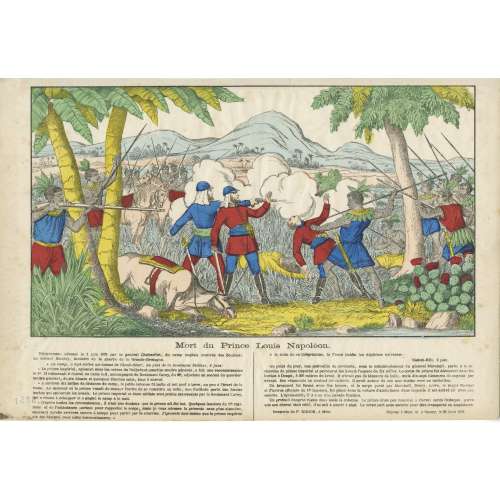 Hand-coloured woodcut on wove paper, 267 x 390 mm. On reverse: black ink stamp “5351”. Centre, under the image frame "Mort du Prince Louis Napoléon". Below left: "Télégramme adressé le 2 juin 1879 par le général Chelmsfort, du camp anglais (contrée des Zoulous), au colonel Stanley, ministre de la guerre de la Grande-Bretagne. « Au camp, à sept milles au-dessus de Blood-River, au pied de la montagne Stellezi, 2 juin: Le prince impérial, agissant sous les ordres de l'adjudant quartier-maitre général. a fait une reconnaissance le 1er. Il retournait à cheval au camp le 2 accompagné du lieutenant Carey, du 98e adjudant en second du quartier-maitre général. de six blancs et, quelques Zoulous amis, tous à cheval. A environ dix milles de distance du camp, la petite colonne fit halte at mit pied à terre, un peu à l’écart de la route. Au moment ou le prince venait de donner l'ordre de se remettre en selle. une fusillade partit des hautes herbes qui entourant les kraals. Le prince impérial et deux soldats sont portés manquants par le lieutenant Carey, qui a réussi à échapper et a gagné le camp à la nuit. D'après toutes les circonstances, il 'est pas douteux quo le prince ait été tué. Quelques lanciers du 17 régiment et de l'ambulance partent pour rapporter le corps; mais je vous adresse la présente sans plus attendre, espérant qu'elle arrivera encore à temps pour partir par le courrier. J’ignorais moi-même que le prince impérial eût été désigné pour cette reconnaissance. »" Below right: A la suite de le télégramme, le Times publie les dépêches suivantes: Stelezi-Hill, 2 juin. Au point du jour, une patrouille de cavalerie, sous le commandement du général Marshall. partit à la recherche du prince impérial et parcourut les kraals l'espace de dix milles. Le corps du prince fut découvert dans les herbes à Donga, à 300 mètres du kraal. Il n'avait pas de blessure de balle, mais dix-sept blessures de zagaies par devant. Ses vêtements lui avaient été enlevés. I avait autour du cou une chaine avec un médaillon. Un brancard fut formé avec les lances, et le corps porté par Marchall, Drury, Lowe, le mjor Stewart et d'autres officiers du 17e lanciers, fut. place dans la voiture d'ambulance dans laquelle il est arrivé ici avec une escorte. L'après-midi, il v a eu une parade funèbre. Un profond chagrin règne dans toute la colonne. Le prince n'est pas remonté à cheval après l’attique, parce que son cheval était rétif ; il se mit à courir à pied. Le corps part sous escorte pour être transporté en Angleterre. Bottom right: "Imagerie de P. DIDION, à Metz — Déposé à Metz et à Nancy, le 25 Juin 1879". Paulin Didion (French, 1831 – 1879) – publisher/printer.
Hand-coloured woodcut on wove paper, 267 x 390 mm. On reverse: black ink stamp “5351”. Centre, under the image frame "Mort du Prince Louis Napoléon". Below left: "Télégramme adressé le 2 juin 1879 par le général Chelmsfort, du camp anglais (contrée des Zoulous), au colonel Stanley, ministre de la guerre de la Grande-Bretagne. « Au camp, à sept milles au-dessus de Blood-River, au pied de la montagne Stellezi, 2 juin: Le prince impérial, agissant sous les ordres de l'adjudant quartier-maitre général. a fait une reconnaissance le 1er. Il retournait à cheval au camp le 2 accompagné du lieutenant Carey, du 98e adjudant en second du quartier-maitre général. de six blancs et, quelques Zoulous amis, tous à cheval. A environ dix milles de distance du camp, la petite colonne fit halte at mit pied à terre, un peu à l’écart de la route. Au moment ou le prince venait de donner l'ordre de se remettre en selle. une fusillade partit des hautes herbes qui entourant les kraals. Le prince impérial et deux soldats sont portés manquants par le lieutenant Carey, qui a réussi à échapper et a gagné le camp à la nuit. D'après toutes les circonstances, il 'est pas douteux quo le prince ait été tué. Quelques lanciers du 17 régiment et de l'ambulance partent pour rapporter le corps; mais je vous adresse la présente sans plus attendre, espérant qu'elle arrivera encore à temps pour partir par le courrier. J’ignorais moi-même que le prince impérial eût été désigné pour cette reconnaissance. »" Below right: A la suite de le télégramme, le Times publie les dépêches suivantes: Stelezi-Hill, 2 juin. Au point du jour, une patrouille de cavalerie, sous le commandement du général Marshall. partit à la recherche du prince impérial et parcourut les kraals l'espace de dix milles. Le corps du prince fut découvert dans les herbes à Donga, à 300 mètres du kraal. Il n'avait pas de blessure de balle, mais dix-sept blessures de zagaies par devant. Ses vêtements lui avaient été enlevés. I avait autour du cou une chaine avec un médaillon. Un brancard fut formé avec les lances, et le corps porté par Marchall, Drury, Lowe, le mjor Stewart et d'autres officiers du 17e lanciers, fut. place dans la voiture d'ambulance dans laquelle il est arrivé ici avec une escorte. L'après-midi, il v a eu une parade funèbre. Un profond chagrin règne dans toute la colonne. Le prince n'est pas remonté à cheval après l’attique, parce que son cheval était rétif ; il se mit à courir à pied. Le corps part sous escorte pour être transporté en Angleterre. Bottom right: "Imagerie de P. DIDION, à Metz — Déposé à Metz et à Nancy, le 25 Juin 1879". Paulin Didion (French, 1831 – 1879) – publisher/printer. -
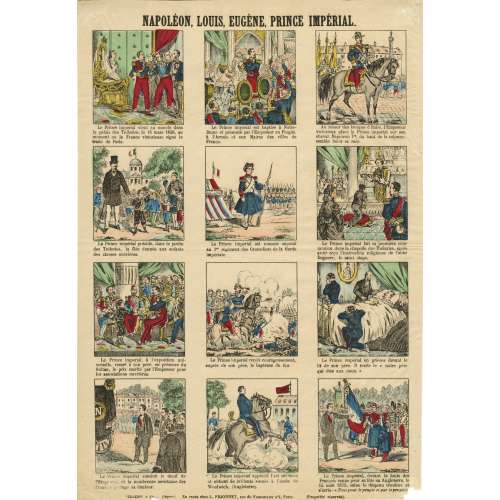 Hand-coloured woodcut on wove paper, 400 x 277 mm. Top: "NAPOLÉON, LOUIS, EUGÈNE, PRINCE IMPÉRIAL"; bellow 12 captioned frames:
Hand-coloured woodcut on wove paper, 400 x 277 mm. Top: "NAPOLÉON, LOUIS, EUGÈNE, PRINCE IMPÉRIAL"; bellow 12 captioned frames:- Le Prince impérial vient au monde dans le palais des Tuileries, le 16 mars 1856, au moment où la France victorieuse signe le traité de Paris.
- Le Prince impérial est baptisé à Notre-Dame et présenté par l'Empereur au Peuple, à l’Armée et aux Maires des villes de France.
- Au retour des troupes d'Italie, l'Empereur victorieux place le Prince impérial sur son cheval. Napoléon Ier, du haut de la colonne, semble bénir sa race.
- Le Prince impérial préside, dans le jardin des Tuileries, la fête donnée aux enfants des classes ouvrières.
- Le Prince impérial est nommé caporal au 1er régiment des Grenadiers de la Garde impériale.
- Le Prince impérial fait sa première communion dans la chapelle des Tuileries, après avoir reçu l'instruction religieuse de l'abbé Deguerry, le saint otage.
- Le Prince impérial, à l'exposition universelle, remet à son père. en présence du Sultan, le prix mérité par l'Empereur pour les associations ouvrières.
- Le Prince impérial reçoit courageusement, auprès de son père, le baptême du feu.
- Le Prince impérial en prières devant le lit de son père. Il récite le « notre père qui ètes aux cieux. »
- Le Prince impérial conduit le deuil de l'Empereur, et la nombreuse assistance des Français portage sa douleur.
- Le Prince impérial apprend l’art militaire et obtient de brillants succès à l'écolo de Woolwich, (Angleterre).
- Le Prince impérial, devant la foule des Français venus pour sa fête en Angleterre, le 15 out 1873, salue le drapeau tricolore et s'écrie : « Tout pour le peuple et par le peuple… »
-
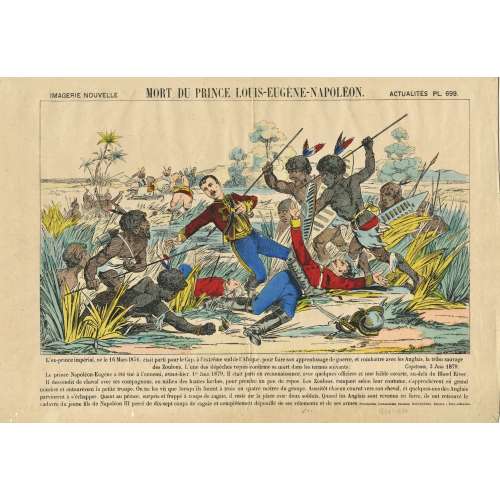 Hand-coloured lithography on wove paper, 275 x 385 mm; vertical centerfold, image in frame. On reverse: black ink stamp “5350”. Above the frame: "IMAGERIE NOUVELLE — MORT DU PRINCE LOUIS-EUGÈNE-NAPOLÉON. — ACTUALITÉS PL. 699". Under the frame: "L'ex-prince impérial, né le 16 Mars I856, était parti pour le Cap, à l'extrême sud de l'Afrique, pour faire son apprentissage de guerre, et combattre avec les Anglais, la tribu sauvage des Zoulous. L'une des dépêches reçues confirme sa mort dans les termes suivants: — Capetown, 3 Juin 1879. — Le prince Napoléon-Eugène a été tué à l'ennemi, avant-hier, 1er Juin 1879, Il était parti en reconnaissance, avec quelques officiers et une fable escorte, au-delà du Blood River. Il descendit de cheval ave ses compagnons, au milieu des hautes herbes, pour prendre un peu de repos. Les Zoulous, rampant selon leur coutume, s'approchèrent en grand nombre et entourèrent la petite troupe. On ne les vit que lorsqu' ils furent à trois ou quatre mètres du groupe. Aussitôt chacun court vers son cheval, et quelques-uns des Anglais parvinrent à s'échapper. Quant au prince, surpris et frappé à coups de zagaie, il resta sur la place avec deux soldats. Quand les Anglais sont revenus en force, ils ont retrouvé le cadavre du jeune fils de Napoléon III percé de dix-sept coups de zagaie et complétement dépouillé de ses vêtements et de ses armes". — "Typographie, Lithographie, Imagerie, Haguenthal, Éditeur à Pont-à-Mousson". Pencil ms: "1860-1880". Élie Haguenthal (French, 1822 – 1881) – publisher/printer.
Hand-coloured lithography on wove paper, 275 x 385 mm; vertical centerfold, image in frame. On reverse: black ink stamp “5350”. Above the frame: "IMAGERIE NOUVELLE — MORT DU PRINCE LOUIS-EUGÈNE-NAPOLÉON. — ACTUALITÉS PL. 699". Under the frame: "L'ex-prince impérial, né le 16 Mars I856, était parti pour le Cap, à l'extrême sud de l'Afrique, pour faire son apprentissage de guerre, et combattre avec les Anglais, la tribu sauvage des Zoulous. L'une des dépêches reçues confirme sa mort dans les termes suivants: — Capetown, 3 Juin 1879. — Le prince Napoléon-Eugène a été tué à l'ennemi, avant-hier, 1er Juin 1879, Il était parti en reconnaissance, avec quelques officiers et une fable escorte, au-delà du Blood River. Il descendit de cheval ave ses compagnons, au milieu des hautes herbes, pour prendre un peu de repos. Les Zoulous, rampant selon leur coutume, s'approchèrent en grand nombre et entourèrent la petite troupe. On ne les vit que lorsqu' ils furent à trois ou quatre mètres du groupe. Aussitôt chacun court vers son cheval, et quelques-uns des Anglais parvinrent à s'échapper. Quant au prince, surpris et frappé à coups de zagaie, il resta sur la place avec deux soldats. Quand les Anglais sont revenus en force, ils ont retrouvé le cadavre du jeune fils de Napoléon III percé de dix-sept coups de zagaie et complétement dépouillé de ses vêtements et de ses armes". — "Typographie, Lithographie, Imagerie, Haguenthal, Éditeur à Pont-à-Mousson". Pencil ms: "1860-1880". Élie Haguenthal (French, 1822 – 1881) – publisher/printer. -
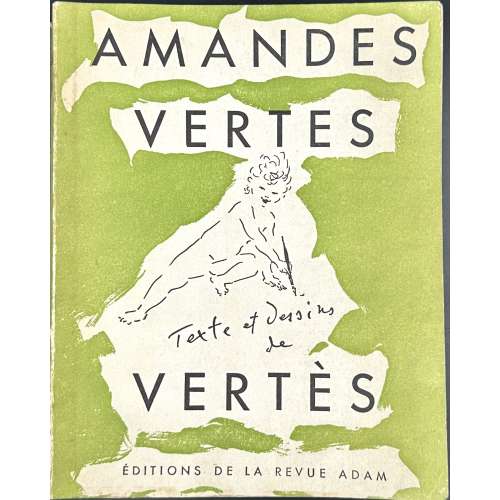 Paperback, 23.7 x 19 cm, green pictorial wrappers, lettering to spine, glassine dust jacket, some pages uncut, signed autograph blue ink inscription to h.t. "Au dr. Manuel Bruker en souvenir d'une harmonieuse collaboration. Vertès, 1952"; pp.[1-6] 7-489 [490] [2], profusely illustrated in b/w., Title-page: AMANDES VERTES | {vignette} | Texte et dessins | de | VERTÈS | ÉDITIONS REVUE ADAM | 4, RUE DE LA PAIX – PARIS – 2e || Limitation: Il a été tiré 200 exemplaires sur papier vélin d'arches; ceux-ci comportent un frontispice inédit en lithographie originale en 3 couleurs signée par l'auteur, tirée par Mourlot frères; ces exemplaires composent l'édition de luxe numérotée de 1 a 200. En plus, 20 exemplaires hors commence ont été réservés a des service personnels; ils sont numérotés de I a XX en chiffres romains. Ces deux éditions forment la totalité du tirage de luxe. Colophon: Achevé d'imprimer le 30 juin 1952 sur les presses de l'imprimerie Hérissey à Évreux numéro d'édition de l'éditeur : 91. Edition limited to 200 copies numbered 1 to 200 and 20 copies numbered from I to XX. This is copy № 91. No coloured frontispiece. Catalogue raisonné: Vokaer № 53. Provenance: Manuel Bruker (French, 1891 – 1979) Contributors: Marcel Vertès [Marcell Vértes] (Jewish-Hungarian-French, 1895 – 1961) – author/artist. Imprimerie Hérissey (Évreux) – printer. Edition Adam La Revue D' Homme [Revue Adam] – publisher.
Paperback, 23.7 x 19 cm, green pictorial wrappers, lettering to spine, glassine dust jacket, some pages uncut, signed autograph blue ink inscription to h.t. "Au dr. Manuel Bruker en souvenir d'une harmonieuse collaboration. Vertès, 1952"; pp.[1-6] 7-489 [490] [2], profusely illustrated in b/w., Title-page: AMANDES VERTES | {vignette} | Texte et dessins | de | VERTÈS | ÉDITIONS REVUE ADAM | 4, RUE DE LA PAIX – PARIS – 2e || Limitation: Il a été tiré 200 exemplaires sur papier vélin d'arches; ceux-ci comportent un frontispice inédit en lithographie originale en 3 couleurs signée par l'auteur, tirée par Mourlot frères; ces exemplaires composent l'édition de luxe numérotée de 1 a 200. En plus, 20 exemplaires hors commence ont été réservés a des service personnels; ils sont numérotés de I a XX en chiffres romains. Ces deux éditions forment la totalité du tirage de luxe. Colophon: Achevé d'imprimer le 30 juin 1952 sur les presses de l'imprimerie Hérissey à Évreux numéro d'édition de l'éditeur : 91. Edition limited to 200 copies numbered 1 to 200 and 20 copies numbered from I to XX. This is copy № 91. No coloured frontispiece. Catalogue raisonné: Vokaer № 53. Provenance: Manuel Bruker (French, 1891 – 1979) Contributors: Marcel Vertès [Marcell Vértes] (Jewish-Hungarian-French, 1895 – 1961) – author/artist. Imprimerie Hérissey (Évreux) – printer. Edition Adam La Revue D' Homme [Revue Adam] – publisher.


